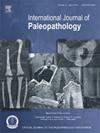18 -19世纪欧洲土著接触时期,在阿根廷巴塔哥尼亚发现的一具人类墓葬中的胃肠道寄生虫
IF 1.5
3区 地球科学
Q3 PALEONTOLOGY
引用次数: 0
摘要
目的研究巴塔哥尼亚地区土著狩猎采集者与欧洲人相互作用期间成年个体胃肠道寄生情况。材料在Aguada del Barril考古遗址的一处人类墓葬的骨盆区域发现了一份沉积物样本,可追溯到18 -19世纪。方法采用标准古寄生虫学技术对约5 g的沉积物进行再水化处理。在光镜下检查材料,并包括阴性对照样品进行比较。结果共鉴定出10个不同种17个寄生虫卵。所有对照载玻片的寄生虫检测均为阴性。这些发现有助于深入了解过去种群的寄生负担和健康状况,同时也反映了人类、家畜和野生动物及其周围环境之间复杂的相互作用。本案例研究为了解早期殖民时期巴塔哥尼亚土著居民的生活方式提供了宝贵的数据。它还强调了使用单一沉积物样本所带来的解释挑战,强调需要更广泛的采样策略来加强古寄生虫学推断。局限性:只分析了一个样品。本案例强调了多样化采样策略对提高古寄生虫学解释分辨率的重要性。本文章由计算机程序翻译,如有差异,请以英文原文为准。
Gastrointestinal parasites in a single human burial from Argentine Patagonia during the 18th-19th-century Indigenous–European Contact Period
Objective
This study aims to assess gastrointestinal parasitism in an adult Indigenous individual during the period of interaction between Indigenous hunter-gatherer groups and European populations in Patagonia.
Materials
A sediment sample was recovered from the pelvic region of a human burial at the Aguada del Barril archaeological site, dated to the 18th-19th centuries.
Methods
Approximately 5 g of sediment were rehydrated and processed using standard paleoparasitological techniques. The material was examined under light microscopy, and negative control samples were included for comparison.
Results
A total of 17 parasite eggs, representing 10 distinct species, were identified. All control slides tested negative for parasites.
Conclusions
These findings provide insight into the parasitic burden and health conditions of past populations, while also reflecting the intricate interactions between humans, domestic and wild animals, and their surrounding environment.
Significance
This case study contributes valuable data to the understanding of Indigenous lifeways in Patagonia during early colonial encounters. It also highlights the interpretative challenges posed by working with a single sediment sample, underscoring the need for broader sampling strategies to strengthen paleoparasitological inferences.
Limitations
Only a single sample was analyzed.
Suggestions for further research
This case underscores the importance of diversified sampling strategies to improve the resolution of paleoparasitological interpretation.
求助全文
通过发布文献求助,成功后即可免费获取论文全文。
去求助
来源期刊

International Journal of Paleopathology
PALEONTOLOGY-PATHOLOGY
CiteScore
2.90
自引率
25.00%
发文量
43
期刊介绍:
Paleopathology is the study and application of methods and techniques for investigating diseases and related conditions from skeletal and soft tissue remains. The International Journal of Paleopathology (IJPP) will publish original and significant articles on human and animal (including hominids) disease, based upon the study of physical remains, including osseous, dental, and preserved soft tissues at a range of methodological levels, from direct observation to molecular, chemical, histological and radiographic analysis. Discussion of ways in which these methods can be applied to the reconstruction of health, disease and life histories in the past is central to the discipline, so the journal would also encourage papers covering interpretive and theoretical issues, and those that place the study of disease at the centre of a bioarchaeological or biocultural approach. Papers dealing with historical evidence relating to disease in the past (rather than history of medicine) will also be published. The journal will also accept significant studies that applied previously developed techniques to new materials, setting the research in the context of current debates on past human and animal health.
 求助内容:
求助内容: 应助结果提醒方式:
应助结果提醒方式:


